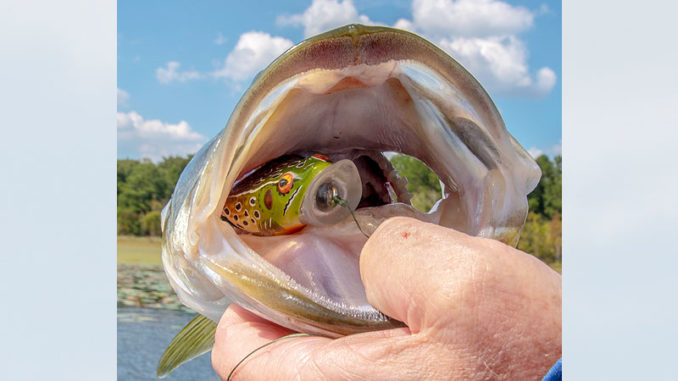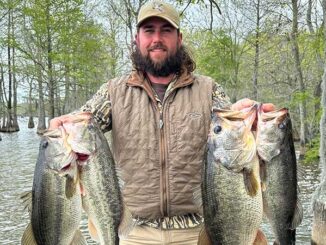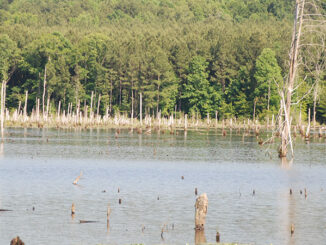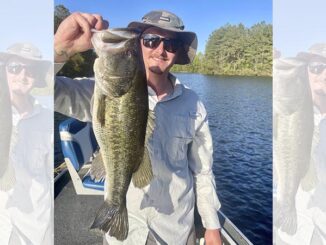
Changes in Tuckertown Lake’s aquatic vegetation has made frog lures a big part of almost every bass fisherman’s tackle box.
After bass pro Dean Rojas almost won the 2004 Bassmaster Classic on Lake Wylie by fishing a hollow-body frog, frogging for bass became a craze. Not only in the Carolinas but throughout the country. Manufacturers produced numerous versions to meet the demand.
Two Lexington, N.C., fishermen, Orlando Giles and Mike Ray, caught fever and adapted the technique to Tuckertown Lake, a 2,600-acre reservoir downstream from High Rock Lake on the Yadkin River.
“Frog fishing at Tuckertown is different from frog fishing at Wylie,” Ray said. “At Wylie, froggers toss their baits at willows, piers, brush, ditches and points in fairly clear water. At Tuckertown, we target black mat algae, stumps and grass in dingy water.”
Neither Giles nor Ray gave much thought to frog fishing at Tuckertown until the lake underwent a habitat transformation in the early 2000s, when grass and algae invaded.
Before that, canary reed grass was the dominant shoreline grass, with stumps, tree laps and rocks the other primary lake features. Most bass were caught with crankbaits, jigs and plastics.
That quickly changed
In September 2006, Dr. Rob Richardson, a professor at N.C. State University, research technician Andrew Gardner and two biologists from the N.C. Wildlife Resources Commission sampled Tuckertown and identified the invaders as black mat algae (Lyngbya) and elodea grass.
Black mat algae consists of stringy mats of entangled filaments that can live year-round and are virtually indestructible. The mats rise to the surface when oxygen becomes trapped underneath, essentially floating them. Conversely, the mats sink when oxygen is forced out.

The algae spread throughout the lake, cloaking shoreline cover and killing almost all of it. It gradually crept out to deep-water structure.
The algae gave fishermen fits, clinging to crankbaits, jigs, plastics, topwaters and spinnerbaits, rendering them almost useless unless a fisherman was willing to handpick the foul-smelling menace off his bait after each cast.
Robinson’s crew identified the grass as elodea but didn’t find any hydrilla, though hydrilla would later infest Tuckertown. Two patches of lily pads were observed in Ellis Creek, aka Newsom’s, in a cut near the house trailers and in the back of the creek. Lily pads were absent from other creeks.
The elodea affected the choice of lures and fishing techniques, but the vegetation wasn’t as much of a nuisance as the algae. Most fishermen welcomed the elodea, but all detested the algae.
Eventually, fishermen discovered a hollow-body frog offered one effective way to fish the black slop with few hang-ups.

Ray, who had prior frog-fishing experience at Lake Norman, encouraged Giles to try the frog at Tuckertown.
“I resided at (Lake) Norman in 1964, before the lake became developed,” said Ray. “I fished a frog in the backs of creeks, so I recognized its potential.”
Another change in habitat took place between 2015 and 2016 because of the Aquatic Weed Project, whereupon Tuckertown was treated with a herbicide that killed much of the grass. Grass carp were added in the lake to further curb the growth of grass.
With the grass greatly diminished, Giles and Ray now focus upon shallow pockets choked with algae for most of their frog fishing. They have plenty of places to fish; the algae had spread from one end of the lake to the other.
“We fish shallow pockets,” said Giles. “I’m speaking of water 2 feet deep or less. We look at our surroundings, and if there are little frogs skipping about the bank, we know we’ll get bites.”
Giles said frog fishing is best in hot weather, though artificial frogs will catch bass from late May through early fall.
The retrieve varies. Giles and Ray either reel the frog straight in, pop it, drag it, twitch it or use a stop-and-go retrieve.
“Let the fish tell you which retrieve is best,” said Giles.

Both anglers use the Spro Bronzeye Frog and alter the bait.
“We trim the rubber extensions for easier retrieval and for reducing short strikes,” Giles said. “We might shorten one side more than the other to give the frog an erratic action to make it walk easier. We bend the double hook out slightly for a better hookset. We make other changes, too.”
Getting a firm hookset with a frog is a problem, even with the right equipment, which usually means a medium-heavy baitcasting rod with backbone and a fast tip. Ray uses a 6-foot-9 Cashion or 7-foot Duckett rod with a Quantum Smoke reel featuring an 8.1:1 gear ratio to move the fish quickly from the matted gook.
Giles is a bit different from other bass fishermen; he uses spinning gear. For frogging, he fishes a heavy action spinning rod, and like Ray, his reel is spooled with 65-pound braided line.
“For every 20 bites with a frog, you’ll land about eight or nine fish,” Giles said, “but every fish will be a big one. The first three bass we caught with a frog each weighed around 6 pounds. It takes a big, aggressive fish to blow up on a frog through that thick algae.”

In one tournament at Tuckertown, Ray and Giles brought in three bass weighing a total of more than 19 pounds, including a 9-pounder Giles caught.
Color choice is fairly basic. Black or black/green frogs for mornings and overcast days; green frogs and frogs in natural patterns for sunny days. If a bass slaps at a frog of one color, try another color.
Current and water color aren’t factors.
“We don’t fish a frog in current,” Giles said. ” Tuckertown is often dingy, but the water under the algae mats is fairly clear. The mats serve as filters.”
To catch a bass that’s a real toad, give a hollow-body frog a try.
The evolution of hollow-body frogs
Fishermen in the Carolinas cite the 2004 Bassmaster Classic on Lake Wylie as the catalyst for the explosion in hollow-body frog fishing for bass.
But frogging is nothing new. Fishermen have been using hollow-body frogs for bass for more than 100 years. And while the Spro Bronzeye may be the best-known hollow-body frog, but it’s by no means the first.

The first hollow-body frog dates to 1895. Called the Hastings Weedless Casting Frog, it was produced by the Hibbard, Spencer & Bartlett Company of Chicago, at a time when the rubber moulding process was in its infancy. The frogs were hand-painted and featured Carlisle hooks with weed guards. If water entered the frog, one squeeze would expel the liquid.
Frogging experienced a rebirth in 1969 with the introduction of Bill Plummer’s Superfrog, later renamed the Superior Frog, which is still sold today. Manufactured by Harrison-Hoge Industries, the frog wasn’t a hollow-bodied rubber frog like today’s models, but rather a foam production.
Plummer’s frog began as a toy frog given to Plummer’s 5-year-old daughter, then converted into a lure with a single hook.
True hollow-body rubber frogs followed, such as the weedless Snag Proof Frog of Ohio with double hooks, by Snag Proof Manufacturing in 1961, and the Scum Frog by Mississippi’s Southern Lures in the 1980s.
Today’s hollow-body frogs include the Booyah Pad Crasher Frog, River2Sea Frog, Strike King KVD Sexy Frog, Livetarget Frog and the Lunkerhunt Poppin’ Frog.
Destination Information
- HOW TO GET THERE — Tuckertown Lake is about 20 miles south of Lexington, N.C., near the community of Healing Springs. Two public landings serve as the main access to the lake: the NC 49 landing and Flat Creek Landing off CR2191.
- WHEN TO GO —Bass devour frogs from the end of May through the summer during the hottest weather.
- BEST TECHNIQUES — Fish shallow stumps, grass or pockets cloaked with black mat algae. Use heavy tackle and 50- to 65-pound braided line to hoist the fish from thick mats of algae.
- FISHING INFO/GUIDES — Maynard Edwards,Yadkin Lakes Guide Service, 336-249-6782.
- ACCOMMODATIONS — Days Inn, Lexington, N.C., 866-599-6674; Super 8, Salisbury, N.C., 855-799-6862; Best Western, Albemarle, N.C., 866-599-6674.
- MAPS — Kingfisher Maps, 800-326-0257, www.kfamaps.com.



